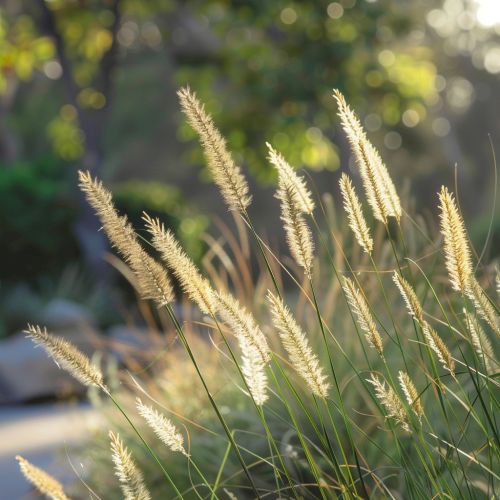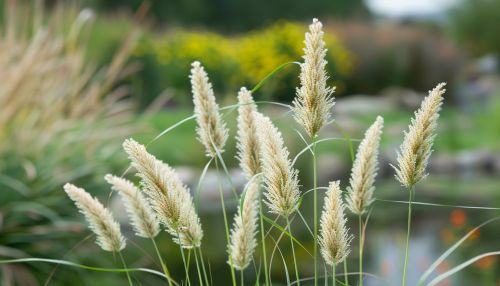Poa
Overview


Poa is a genus of grasses, commonly referred to as bluegrasses, meadow-grasses, or tussock-grasses. It is one of the most widespread and diverse genera within the family Poaceae, encompassing over 500 species. These grasses are predominantly found in temperate and cold regions across the globe. The genus name "Poa" is derived from the Greek word for fodder, reflecting its historical and ongoing importance in agriculture and grazing.
Taxonomy and Classification
The genus Poa falls under the subfamily Pooideae, which is characterized by its cool-season grasses. Within the Poaceae family, Poa is part of the tribe Poeae. The genus is further divided into several sections based on morphological characteristics such as inflorescence structure, leaf blade anatomy, and reproductive features.
Major Species
Some of the most notable species within the Poa genus include:
- Poa pratensis (Kentucky bluegrass)
- Poa annua (Annual bluegrass)
- Poa trivialis (Rough bluegrass)
- Poa alpina (Alpine bluegrass)
Each of these species has unique adaptations and ecological roles, contributing to their widespread distribution and ecological significance.
Morphology
Poa species exhibit a wide range of morphological traits, but they share several common features. These grasses typically have narrow, linear leaves with parallel venation. The leaf blades are often soft and flexible, with a boat-shaped tip. The inflorescence is usually a panicle, which can vary in density and branching patterns.
Root System
The root systems of Poa species are generally fibrous, allowing them to effectively anchor in various soil types and resist erosion. Some species, like Poa pratensis, have rhizomatous growth habits, enabling them to spread vegetatively and form dense swards.
Reproductive Structures
Poa species are predominantly wind-pollinated, with flowers that lack prominent petals. The florets are typically arranged in spikelets, each containing one to several florets. The lemma and palea, which are specialized bracts, enclose the reproductive organs. The presence of awns (bristle-like appendages) on the lemma can vary among species and is often used as a diagnostic feature.
Ecology and Habitat
Poa species occupy a wide range of habitats, from lowland meadows and pastures to alpine tundra and arctic regions. They are particularly well-adapted to temperate climates, where they play crucial roles in natural and managed ecosystems.
Adaptations
Many Poa species exhibit adaptations to cold and drought conditions. For instance, Poa pratensis has a deep root system that allows it to access water during dry periods, while Poa alpina can survive in high-altitude environments with low temperatures and short growing seasons.
Ecological Roles
Poa grasses are important components of grassland ecosystems, providing forage for herbivores and contributing to soil stabilization. They also play a role in nutrient cycling and support a variety of wildlife, including insects, birds, and small mammals.
Agricultural and Horticultural Significance
Poa species are widely used in agriculture, horticulture, and turf management. Kentucky bluegrass (Poa pratensis) is one of the most popular turfgrasses in North America, valued for its fine texture, durability, and aesthetic appeal.
Forage and Grazing
Many Poa species are utilized as forage for livestock due to their palatability and nutritional value. They are often included in pasture mixes to enhance grazing quality and support sustainable livestock production.
Turf and Lawn Management
Poa species are commonly used in lawns, sports fields, and golf courses. Their ability to form dense, resilient swards makes them ideal for high-traffic areas. However, some species, like Poa annua, can become problematic weeds in turf settings due to their aggressive growth and tendency to outcompete desirable grasses.
Conservation and Management
The conservation and management of Poa species involve balancing their ecological benefits with the challenges they pose in certain contexts. Efforts to preserve native Poa populations focus on habitat protection and restoration, while managing invasive species requires targeted control measures.
Invasive Species
Some Poa species, such as Poa annua, have become invasive in various regions, disrupting native plant communities and altering ecosystem dynamics. Management strategies for invasive Poa species include mechanical removal, herbicide application, and promoting the growth of competitive native vegetation.
Conservation Efforts
Conservation efforts for Poa species often involve protecting natural habitats from degradation and fragmentation. In regions where native Poa species are threatened, conservation programs may include seed banking, habitat restoration, and public education initiatives.
Research and Future Directions
Ongoing research on Poa species aims to enhance our understanding of their genetics, physiology, and ecological interactions. Advances in molecular biology and genomics are providing new insights into the evolutionary history and adaptive mechanisms of these grasses.
Genetic Studies
Genetic studies of Poa species are revealing the complexity of their evolutionary relationships and the genetic basis of their adaptations. This research has implications for breeding programs aimed at developing improved forage and turf varieties with enhanced stress tolerance and disease resistance.
Ecological Research
Ecological research on Poa species is focused on their roles in ecosystem functioning and their responses to environmental changes. Understanding how Poa grasses interact with other species and their environment can inform conservation and management practices.
